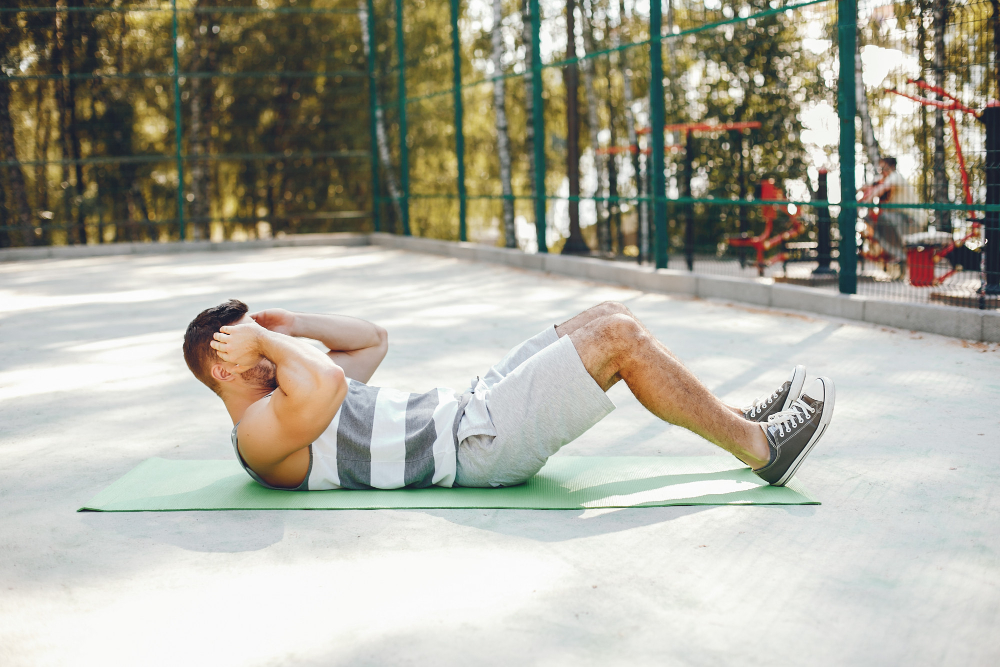Side crunches are effective exercises that target the oblique muscles, contributing to a strong and well-defined core. A robust core is essential for overall fitness as it underpins virtually every physical activity, from walking and running to lifting and bending. Importantly, the core muscles also support the spine and contribute to good posture, reducing the risk of back pain and injury. This article will place a spotlight on how to do side crunches, delving into the technique, benefits, common mistakes, and variations of this foundational core exercise.
Know Everything About Side Crunches
Side crunches are a variation of the traditional ab crunch, designed to target the oblique muscles situated on the sides of your abdominal area. They’re performed by lying on your side and lifting your upper body towards your bent knees, thereby creating a “crunching” motion.
Side crunches not only work your external and internal obliques, but they also engage the core stabilizers, including the transverse abdominis and the multifidus muscles. These core stabilizing muscles play a vital role in maintaining balance, enabling movement, and supporting the spine, making side crunches an integral part of a comprehensive core workout.
Proper Form and Technique
To perform side crunches correctly, start by lying on your right side with your legs stacked on top of each other and your right arm supporting your head. Your left arm should be resting in front of your body for balance. Bend your knees at a 90-degree angle.
Engaging your core, lift your upper body towards your hip while keeping your legs and hips grounded. Your elbow should be moving towards your waist. Ensure to squeeze the obliques as you lift your body, then slowly lower back down to the starting position. The movement should be controlled and steady, not rushed or jerky.
Repeat the set on your right side, then switch to your left side and complete an equal number of repetitions. Remember, the key is to focus on the quality of movement rather than the quantity of repetitions. It is more beneficial to do fewer crunches with correct form than a larger number with poor form.
Throughout the exercise, ensure your neck and shoulders are relaxed to avoid straining or injury. Your core muscles should be doing the work, not your neck or shoulders. Also, remember to breathe – exhale as you crunch up and inhale as you return to the starting position.
Injuries like neck strain, back pain, or pelvic tilt can occur from incorrect form and muscle imbalances or weaknesses. They can also be the result of overtraining or doing too many repetitions with bad form. If you find it challenging to maintain proper form, start with easier variations and gradually build up to the standard side crunch.
Variations of Side Crunches
Diversifying your workout regime with different variations of side crunches can enhance your core strength and keep your exercise routine interesting. These variations target the same muscle groups but from different angles and levels of intensity, offering a comprehensive abdominal workout. Each variation will be broken down to highlight the correct technique, ensuring you get the most out of your activity while minimizing the risk of injury. Here are some alternatives and how they can add an exciting twist to your regular fitness routine.
Standing side crunches
Standing side crunches are an excellent option for beginners or those with mobility issues. Standing up will put less strain on your neck and is also an excellent way to engage your core while targeting the obliques.
To perform standing side crunches, stand with your feet apart and arms by your side. Raise one arm above your head while bending at the waist in the opposite direction. Return to the starting position and repeat on the other side. Aim for 12-15 repetitions per set.
Side plank crunches
Side plank crunches are a challenging variation that requires a certain level of core strength. They target not just the obliques but also work the entire core and challenge your balance and stability. To perform this exercise, start in a side plank position with your feet stacked and one hand on the ground, supporting your body weight. Bring your top knee towards your elbow while engaging your core. Return to the starting position and repeat for 10-12 repetitions on each side.
Bicycle crunches
Bicycle crunches are a total-body exercise that works both the abdominal muscles and the legs. They also target the obliques by mimicking a cycling motion. To begin, put your hands behind your head, then lie on your back. Bend your knees at a 90-degree angle. Lift your shoulders off the ground while twisting to bring one elbow towards the opposite knee. Alternate between sides for 10-12 repetitions per side.
These variations can also target different aspects of your core, such as the lower abs or the upper abs. This will help you achieve a well-rounded and sculpted core. Mixing and matching different variations into your workout can increase core strength and challenge your muscles in new ways.
How To Do Side Crunches
Performing Side Crunches the Right Way
While this article already touched on performing side crunches briefly, this section will provide you with a more detailed, step-by-step guide on how to achieve them. This will help ensure you’re performing the exercise with proper form, gaining maximum benefits while minimizing the risk of injury. Follow these steps to perform a side crunch:
Position Yourself
Lie down on your right side with your feet and legs stacked on top of each other. Place your right hand behind your head with your elbow pointed upward. Your left arm can be extended on the floor for balance or placed on your left side.
Set Your Legs
Bend your knees at a 90-degree angle, aligning your thighs with your body. Your feet should remain stacked throughout the exercise.
Perform The Crunch
Keeping your lower body stationary, exhale and lift your upper body. Aim to bring your right elbow towards your right hip. Your head and shoulders should lift off the floor, and you should feel a contraction on the right side of your abdominal muscles.
Return To Start
Inhale and slowly lower your upper body back to the starting position, maintaining control and not allowing your muscles to relax completely. This ensures your muscles remain engaged throughout the entire exercise.
Repeat
Perform the desired number of repetitions on the right side before switching to your left side. It’s crucial to maintain balance and work both sides equally.
Remember, the key is not speed but the quality of the movement. Focus on maintaining proper form and control over speed or the number of repetitions. Be sure to keep your actions steady, and always keep your core engaged. The focus should be on the oblique muscles doing the work, not the neck or shoulders. If you experience any pain or discomfort, stop the exercise and consult with a fitness professional.
Breathing Techniques and Common Mistakes To Avoid
Proper breathing is essential when performing any exercise, but it’s especially important during side crunches. Here are some tips to help you breathe correctly while doing side crunches:
- Inhale through your nose as you lower yourself back to the starting position.
- Exhale through your mouth as you lift your upper body towards your hip.
By following this breathing technique, you can maintain proper form and promote better oxygen flow to your muscles. Additionally, here are some common mistakes to avoid when performing side crunches:
- Using momentum instead of engaging your core muscles: Remember, the focus should be on using your oblique muscles, not relying on swinging or jerking movements to lift yourself.
- Straining your neck or shoulders: Keep these areas relaxed throughout the exercise and focus on your core doing the work.
- Overarching or twisting: Keep your body in a straight line, avoiding any excessive arching of your back or twisting motions.
- Not breathing correctly: As mentioned earlier, proper breathing can make all the difference in maintaining good form and getting the most out of your workout.
Proper breathing and avoiding these common mistakes will help you get the most out of your side crunches and minimize the risk of injury.
Key Points in the Execution of Side Crunches
When performing side crunches, it is essential to keep certain key points in mind to ensure optimal execution and maximize the benefits of this exercise. Some of these key points were already discussed, but here’s a quick summary to ensure you remember them all:
- Position: Lie on your side with your legs stacked and your lower arm supporting your head. The upper arm may rest on the floor or on your side.
- Legs Set: Bend your knees at a 90-degree angle, maintaining alignment with your body.
- The Crunch: Engage your core and lift your upper body, bringing your elbow towards your hip. The movement should originate from your obliques.
- Return to Start: Lower your upper body back to the starting position, keeping the movement controlled and the muscles engaged.
- Repetition: Conduct the desired number of repetitions before swapping sides. Balance in muscle engagement is crucial.
- Breathing: Exhale as you lift your upper body and inhale as you lower it. Proper breathing aids form and promote better oxygen flow.
- Avoid Common Mistakes: Keep your neck and shoulders relaxed your body straight, and avoid using momentum or rushing through the exercise.
These key points ensure that you are executing the side crunches correctly, optimizing the activation of your core muscles, and minimizing the risk of potential injuries.
Amazing Benefits Of Performing Side Crunches
While this article already briefly touched on the benefits of side crunches in the introduction, this section will provide a detailed overview of the many ways side crunches can benefit your overall health and fitness. Here are four fantastic benefits of incorporating side crunches into your workout routine:
Core Strength
Core strength is perhaps the most obvious benefit of performing side crunches. As discussed earlier, this exercise targets not just the obliques but also works other core stabilizing muscles like the transverse abdominis and multifidus. A strong core can enhance overall physical performance and help reduce the risk of injury in other activities.
Stability and Balance
Side crunches also help in improving balance and stability, mainly when performing standing variations or challenging exercises like side plank crunches. This is because side crunches engage multiple muscle groups, including the core stabilizers, which work together to keep you balanced.
Better Posture
A weak core can lead to poor posture, resulting in back pain or discomfort. Side crunches help strengthen the core muscles, providing better support for the spine and improving posture. This can also have positive effects on daily activities like sitting at a desk or lifting heavy objects.
Oblique Definition and Toning
Side crunches target the oblique muscles, which run down both sides of the waist and are responsible for twisting and bending movements. By performing this exercise regularly, you can enhance the definition of your obliques, giving you a toned and sculpted midsection. A well-toned midsection not only looks great but also provides better support for the spine and improves overall physical performance. Additionally, it can boost confidence and promote a positive body image.
Reduced Risk of Lower Back Pain
Lower back pain is a common issue, often caused by weak core muscles and poor posture. As side crunches target multiple core muscles, they can help strengthen the entire core area, reducing the risk of lower back pain. This exercise also targets the multifidus muscle, which runs along the spine and helps support it. Studies have shown that strengthening this muscle can help alleviate lower back pain.
These benefits make side crunches an excellent addition to your workout regime, providing not just a well-defined midsection but also promoting overall health and fitness. Remember to start with proper form and gradually increase the intensity of your workouts for maximum results.
Conclusion
Side crunches are a highly effective exercise for strengthening the core, improving balance and stability, achieving better posture, defining and toning the obliques, and reducing the risk of lower back pain. The key to successful execution lies in the correct positioning, controlled movement, proper breathing, and consistent repetition while avoiding common mistakes. Regularly incorporating side crunches into your workout routine can yield impressive results, providing a well-rounded, comprehensive core workout that enhances your overall physical performance and health.






